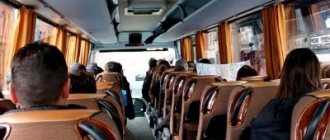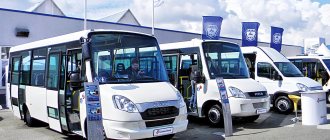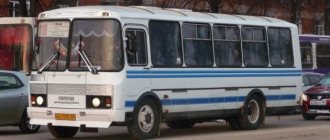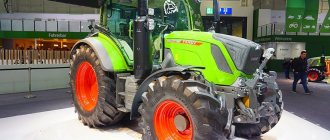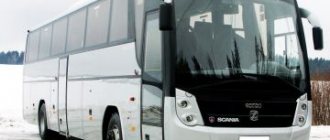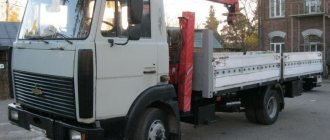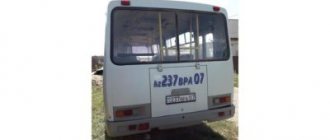In modern bus fleets you can find a huge number of modifications of buses, differing not only in the number of seats, but also in their layout in the cabin. There is no single scheme common to all manufacturers. And not only manufacturing companies, but also the carriers themselves can re-equip the cabin at their discretion. Therefore, even equipment of the same brand and year of manufacture may have a different number of seats and their numbering.
The only requirement for such actions is not to violate established safety rules.
You can see the most common seating arrangements in long-distance buses in the photo:
Location of seats in various modifications of PAZ buses
The total capacity of the PAZ-32053 modification is 41 passengers, seating capacity is 25. The numbering in the cabin is very confusing. The first three seats, located to the right of the driver and facing the passenger compartment, have numbers 23, 24, 25. Next on the left are numbers 5 and 6, located parallel to the axis of the cabin, and only after them on the left side are seats 1, 2, 3, 4. The right row starts with numbers 21, 22. Other options are possible.
The PAZ 4234 model belongs to the small class bus equipment. It has 25 seats and an additional 18 passengers can ride standing.
The photo of the layout of the seats inside the bus shows that all seats, except the rear one on the right, are located in the direction of travel of the car. In the modification, which has 30 passenger seats, there are three combined seats in front facing the interior of the cabin. In the latter case, the numbers of the first three seats are 30, 1, 2. Seats 3 and 4 are located in the row on the left. Further, all numbers follow in order.
In the VECTOR NEXT groove, depending on the purpose (urban/suburban), several options for completing the internal space are provided.
Seats can be 17, 21, 25.
Full technical specifications of the Hyundai County bus
| Vehicle make | HYUNDAI COUNTY | |
| Modification | SWB | |
| Vehicle category | M3, bus class | |
| GENERAL CHARACTERISTICS OF THE MACHINE | ||
| Wheel formula / drive wheels | 4 x 2 / rear | |
| Vehicle layout diagram | carriage; engine location – front longitudinal | |
| Body type / number of doors | carriage, single-storey, closed, all-metal, mounted on a frame / 3 (two doors on the starboard side, driver's door on the left side) | |
| For modifications | SWB | |
| class A | class B | |
| Number of seats | 12+1 | 18+1 or 19+1 |
| Passenger capacity, persons | 22 | 18 or 19 |
| Overall dimensions, mm | ||
| -length | 6345 | |
| -width | 2035 | |
| -height | 2710 | |
| Base, mm | 3350 | |
| Front/rear wheel track, mm | 1705 / 1495 | |
| Weight of the equipped vehicle, kg (according to GOST R 52051-2003) | 4300 | 3945 |
| Gross vehicle weight, kg | 5800 | 5223 |
| Total weight attributable to | ||
| — on the front axle, kg | 2850 | 2141 |
| — on the rear axle, kg | 2950 | 3082 |
| Engine | Hyundai motor company (HMC), D4DD, four-stroke diesel, turbocharged and intercooled | |
| number and arrangement of cylinders | 4, in-line | |
| working volume (cm3) | 3907 | |
| compression ratio | 17.5 : 1 | |
| Maximum power, kW (min-1) | 106,6 (2800) | |
| Maximum torque, Nm (min-1) | 392,4 (1600) | |
| Fuel | diesel | |
| Environmental class | 3 | |
| Supply system | pressure fuel injection | |
| Exhaust gas exhaust and neutralization system | one muffler, no neutralization system | |
| Transmission | ||
| Clutch | dry, hydraulically driven | |
| Transmission | mechanical | |
| — number of gears | forward – 5, backward – 1 | |
| Gear ratios | ||
| —I | 5.380 | |
| —II | 3.028 | |
| — III | 1.700 | |
| — IV | 1.000 | |
| -V | 0.722 | |
| — 3.X. | 5.380 | |
| main gear | NYSA, hypoid | |
| - gear ratio | 5.375 | |
| Suspension | ||
| - front | dependent, leaf spring, with hydraulic telescopic shock absorbers, with anti-roll bar | |
| - rear | dependent, leaf spring, with hydraulic telescopic shock absorbers, with anti-roll bar | |
| Steering | HYUNDAI, steering gear type “screw-ball nut-rack-sector”, power steering | |
| Brake systems | ||
| - working | hydraulic dual-circuit drive with division into circuits along the axes, with amplifier, with ABS; all wheel brakes - drum | |
| - spare | each circuit of the service brake system | |
| - parking | transmission brake mechanism with mechanical (cable) drive | |
| - auxiliary | engine brake retarder | |
| Tires | ||
| - size | 225/75 R17.5 | |
| — bearing capacity index | 126/124 | |
| — speed category | M | |
| Preheater: | Liquid pre-heater (autonomous heater) with two heat guns in the cabin | |
| Features: | Satellite system "GLONASS" (by agreement with the customer) | |
Seat layouts for KAvZ buses
KAvZ brand buses belong to the middle class equipment used on suburban and intercity routes. The number of passenger seats is 31, the total capacity is 54 people.
All seats are located along the direction of the cabin. The numbers start from the first row, on the right side, with the seat located near the aisle.
The KAvZ 4238 equipment has, depending on the modification, 34, 35 or 39 seats. Numbering is standard. Models are used for suburban and intercity routes, as well as school cars.
Hyundai County minibus equipment
| Standard (NMS) | Standard (RZGA) |
| Forced intake manifold system | Power steering |
| Power steering | Tachometer |
| Wheel covers | Fog lights |
| Tachometer | Mountain brake |
| Radio tape recorder | Front heater |
| Fabric upholstery for passenger seats | Passenger heater |
| Passenger visor | Front sliding door |
| Paul-Laxstrong | Sliding tinted side windows |
| Front folding door | Adjustable steering column |
| Tinted stripe on the windshield | ABS brake system |
| Tinted side sliding windows | Autonomous liquid heater |
| Fire extinguisher | Brake force regulator |
Seat arrangement options for Hyundai buses
Hyundai Universe large-capacity tourist buses have 43 or 47 passenger seats, separated from the driver's seat by a solid partition. There is a guide chair to the right of the driver. The numbers start from the left seat of the first row.
You can choose a passenger bus for city, suburban, intercity routes with the required interior layout. Most models are in stock.
So, you are probably wondering - what kind of buses are these on which you will make your wonderful trips to different cities and countries? These are cars specially designed for tourism, which are produced by a variety of companies. You certainly know some, for example, Mercedes, Neoplan, but most companies that produce tourist buses (Van-Hool, Setra) are usually little known among people not involved in the tourism business, but at the same time, these are in their field.
Moving away from stereotypes and big names, let's find out what buses exist for tourist trips? First of all, they can be divided into one-story, one-and-a-half and two-story. Decent companies that care about their clients use only one-and-a-half and double-decker buses, which are considered the most convenient for tourist purposes.
Differences between one and a half and double decker buses
The difference between these buses is that in a one-and-a-half-decker bus the floor with passengers is raised relative to the level of the drivers and is the only passenger floor, while on a 2-decker bus there is a first floor where passengers can also sit. Now let's move on to the interior of the bus. It is quite standard, although it may differ in some not very significant details. The seats are always positioned the same way, as shown in the photo, only the distance between them differs.
Interior of a modern bus
It depends on the class of the bus - the more stars, the greater the distance between the seats and the fewer seats there are. But in any case, there is enough space, in addition, you can always recline the back, or move the seats apart from each other. As for the number of seats on the bus, depending on the manufacturer, the number of seats varies slightly, but on average for a one and a half bus it is 42 seats, and for a two-story - 62 seats. There are also seats on the buses with a table, depending on the type of bus there may be a different number of them.
In addition to external data and the number of seats, buses differ in equipment, i.e. the presence of an acoustic system (music), a video system (set: color monitors suspended from the ceiling, usually 2, 3 or 4, and a VCR), air conditioning, bio-toilet (although the toilet is always present).
This is what TVs look like now in the salon
And finally, it is worth adding that the undoubted advantages of tourist buses include the luggage compartment, which can accommodate a very large amount of a wide variety of luggage.
So, this is the main thing that can be said about the buses that travel companies offer.
When buying tickets, regulars of bus tours first of all pay attention to the location of the seats. Why is it important? Let's explain with an example.
Imagine that you have been planning your trip for a long time, thought through the route, and chose what you thought was a good place - with an excellent view, in the middle of the bus, not far from the door. And then it turned out that it was almost the only one that did not fold out. Everything would be fine, but only when the passengers in front reclined their seats did you find yourself squeezed on both sides. As a result, what was dreamed of as a wonderful journey turned into torture.
We will tell you in the article about all the nuances that you need to take into account when choosing a seat on the bus in order to avoid getting into a similar situation.
Performance characteristics in numbers
Below are the technical characteristics of the Ikarus 280:
- Dimensions – 16.5/2.5/3.16 m.
- Capacity – 168 people.
- The body is of an all-metal load-bearing type.
- The power unit is a Raba four-stroke diesel engine.
- Compression – 17.
- The maximum power indicator is 192 hp. With.
- Speed – 66.5 km/h.
- Base – 5.4/6.2 m.
- Front/middle/rear wheel track – 2.0/1.83/2.0 m.
- Turning radius – 10.5 m.
- Ground clearance – 35 cm.
- Fuel tank capacity – 250 l.
- Curb weight – 12.54 tons.
- The approach angle is 17.2 percent.
Long distance buses - good and different
If you think that knowing the seat number is enough to understand how comfortable it is, you are deeply mistaken. The fleet of modern long-distance buses (LDBs) is so diverse that until you see the layout of the interior, it is premature to draw conclusions.
For example, you got seat number 14. In a tourist MAN with 59 seats, this is the beginning of the cabin, 4th row; but in the cabin of the same model with 45 seats, seat No. 14 is located in front of the door and, most likely, does not recline. In a 20-seater Mercedes, the same number 14 is located on the left by the window at the end of the cabin, and in a 45-seater it is on the right by the aisle, 4th row. And a lot of such examples can be given.
Even the typical diagram of a specific model is not always accurate, since the carrier has the right to make design changes - add a bathroom, a kitchen, remove some of the seats (for example, the back row), and equip a sleeping or cargo compartment.
"Shorty"
We were wrong when we believed that two- and three-axle Scania buses differ only in length and number of axles. There were much more differences.
The distance between the seats in a 12-meter airliner is 2 cm greater than in a 15-meter one. But the left and right sides turned out to be identical.
The most noticeable difference was the manual gearbox. It turned out to be quite convenient to manipulate the control joystick, mounted on the right side of the driver's seat. To avoid the hollow of your uniform jacket from clinging to the knob, the driver’s seat can be turned towards the aisle, significantly facilitating the process of boarding the cab. Due to the lack of an on-board computer, the dashboard on the short bus is different. No worse or better, just different. Instruments and warning lamps are arranged differently.
The hardware changes aren't limited to the less powerful engine and simpler gearbox. Due to the use of a dependent suspension in front, there was a slight rearrangement of the auxiliary equipment. The front air reservoir moved behind the axle, closer to the center and became even more inaccessible for maintenance. Now you can only get to it by driving the bus into a pit. One consolation is that you will have to bleed off the condensate manually only after several years of intensive use.
Due to the absence of a rear steering axle, the need to pull a bunch of pipelines under the bottom disappeared. Instead of five, there were only two left there, which means the number of vulnerable elements in one of the most damaged places on our potholes has been halved.
The reduced length somewhat improved the maneuverability of the bus in cramped city conditions. The remaining differences between a two-axle vehicle and a bus with a 6x2 wheel arrangement are not so striking, and therefore we will not dwell on them.
Site selection criteria
As we know, there is no dispute about tastes, so everyone may have their own criteria for choosing a convenient place. Experienced tourists recommend first of all taking into account such parameters as:
- safety;
- arrangement of seats in relation to the door;
- cabin segment (beginning, middle, end).
Let's look at them in more detail.
Dangerous and safe
Reports of road incidents involving ADF appear with alarming frequency, making it every traveller's No. 1 priority to reach their destination in one piece.
What places are potentially dangerous?
- First row, especially to the right of the aisle. In a head-on collision, they are the first to be hit.
- The last row may be damaged if the impact comes from behind. In addition, during sudden braking, rear row passengers have a higher risk of injury by flying into the aisle.
- Armchairs by the window on the left side of the cabin. We drive on the right side, so this side of the bus is always turned towards the flow of traffic.
The safest seats on a long-distance bus are as follows.
- In the middle of the cabin on the right side. But even in this relatively safe zone, it is better to sit not by the window, but near the aisle.
- The seats are immediately behind the driver. It is believed that the driver, instinctively avoiding danger, removes this zone from the impact, and, on the contrary, exposes the right side.
“Insidious” – next to the door
Places located in close proximity to the door are especially “tricky”.
If they are behind it, in winter and autumn, this is a zone of cold air currents that hit passengers every time the door opens. By the way, in summer the influx of fresh air can rather be considered a plus.
If the seats are on the right side in front of the door in the middle of the cabin, they do not recline. This is designed so as not to interfere with people getting off at stops. Typically, such seats are cheaper, but passengers do not always fully understand the reason for the bonus.
The area next to the door is not without its merits. You will be the first to get off the bus at the parking lot, which means you will get to the buffet, toilet, or just have time to smoke faster.
Disadvantages of the back rows
Few people like the last row in the ADF. And there is good reason for this.
- It shakes more violently here, and people with seasickness get seasick.
- The backs of the seats do not recline, which means there is no opportunity to relax or take a nap.
- If you use a general air conditioner rather than a climate control system to cool the air, it blows strongly from behind.
- If there is only one TV, you cannot see or hear it from the back row. The same goes for a guide during an excursion.
Some tour operators usually sell two tickets for the last row of 5 seats. Then their owners will have the opportunity not only to sit down, but also to lie down fully.
Engine "Ikarus 280"
The power plant is located under the floor of the passenger section. The engine is a six-cylinder diesel engine of the Raba-MAN D2156 HM6U type. Its brief parameters:
- Working volume – 10.35 l.
- Power indicator – 190 horsepower.
- Torque – 710 Nm.
- The location of the cylinder block is horizontal. Thanks to this solution, the unit turned out to be compact, which had a positive effect on reducing the center of gravity, making the equipment resistant to tipping.
The ASH 75.2-A8 five-speed manual transmission interacts with the engine. The engine service life before major overhaul is impressive, provided proper maintenance and appropriate care. The average figure in this regard is at least half a million kilometers. Timely capitalization extended the life of the part by another 150 thousand.
Features of choosing a seat on a double-decker bus
A travel agency may offer you a trip on a double-decker bus. This vehicle has a different seat layout and its own characteristics.
To decide which is best for you, study the pros and cons of each floor.
Advantages of the first floor:
- spacious interior;
- there are fewer people than at the top;
- comfortable tables;
- Nearby there is a bathroom, kitchen, water cooler, refrigerator.
Of the minuses
The cabin is located low in relation to the road, so you won’t be able to admire the panoramic views.
Be prepared for drivers to continue chatting in the evening, and perhaps listen to music or watch a movie.
Advantages of the second floor
- magnificent panoramic view;
- Quiet in the evening, because the drivers are below.
There are also disadvantages
It is more cramped here than on the first floor, which will be especially felt by tall and obese passengers.
Be prepared to descend each time to use the facilities or during stops. The second floor is not for people with disabilities.
And instead of a conclusion. Having chosen a place you like, make sure that it is officially indicated in the voucher (everything is clear with the ticket), otherwise it will turn out like in that joke - whoever gets up first gets the slippers.
Excursion tourism seems to be specially designed for bus tours. Today this type of travel is becoming increasingly popular. Comfortable long-distance buses allow you to enjoy the pleasure of learning new things while traveling. This type of transport is significantly different from city buses.
Long-distance buses are equipped with special soft seats with reclining backrests and armrests. They have a cavity for carrying passenger cargo, including shelves above the seats and a large space under the floor of the bus interior. The cabin itself may have not only a chemical toilet, but also a dispenser with cold and hot water, a mini-fridge, a TV screen and other devices to make the trip comfortable.
When choosing a bus for a long excursion tour, you need to take into account all these features and ask in advance how comfortable you will be on the road. Another important point is the safe location in the ADS cabin. When purchasing a ticket, the seats belong to the passengers in the same way as on the train, so they cannot be changed in the future. Seating layouts vary between buses.
Long-distance buses are a popular type of transport, so many different modifications of such vehicles are produced. In addition, the carrier has the right to independently equip the ADS cabin at its own discretion. Therefore, even buses produced at the same plant at the same time may differ in both the number of seats and their location.
In particular, the standard MAN tourist bus is designed to accommodate 59 seats, and the numbering starts from the first seat and from the right row. However, the MAN Lion's Coach R 08 modification has only 49 seats, while number one has a seat in the second row on the right. The first seats from the door are not numbered, as a result of which the last ones receive numbers 47 and 49.
The location of the seats on the MAN Lions Coach R 08 bus. The location of the seats on the MAN bus.
Such differences can be found in buses of all brands. For example, the small Mercedes 22360C is designed for 20 seats, and the numbering order is confused. The first seats 1 and 2 are located behind the driver, and the seats next to him are numbered 19 and 20. Further rows are numbered from right to left. Another bus from the same manufacturer, Mersedes-Benz 0303, is numbered from left to right and can accommodate 45 seated passengers.
Seat arrangement in Seat arrangement in the Mercedes-Benz bus 0303
bus Mercedes-22360C
The carrier can also change the arrangement of seats and equipment of the bus, for example, remove several seats, add a dry closet, or make room for office space. Depending on such innovations, the number and sometimes the location of passenger seats will change. Therefore, when buying a ticket, you need to carefully study the actual bus layout by asking the carrier for it.
Bus Gazelle Next | GAZelle NEXT club
The Gazelle Next minibus based on an all-metal van is designed to accommodate 16 seats. The new generation of Next buses is maximally adapted to ensure that passengers experience comfort and complete safety.
The bus is designed for increased convenience when entering and exiting the cabin; for this, the manufacturers laid down several points:
- the salon is equipped with a high ceiling of 1.90 m;
- high side door;
- there is a low step at the entrance;
- ergonomically located seats with seat belts;
- LED lighting;
- panoramic glazing system.
In summer, the temperature in the cabin is maintained by air conditioning, and in winter by a heating system of 3 units. The power elements of the car in the body, which may be subject to deformation during transportation, were equipped with increased rigidity. The body of the Next bus is galvanized steel, some elements were replaced with high-strength plastic. Thanks to these materials, Gazelle is protected from corrosion and functionality is increased.
The Next generation of Gazelles has been improved with new technologies, which have a positive effect during operation:
- use of Atsumitec Toyota Tsusho remote drive;
- 80-liter plastic fuel tank;
- The rear suspension was equipped with Mango shock absorbers and updated springs;
- The frame is equipped with upper and lower reinforcements.
Updating and introducing new technologies allows the Gazelle Next to drive smoothly on roads with any surface, while the driver and passengers feel calm and comfortable. The new van was created using old developments that have confirmed their reliability. For example, the new Next Gazelles use a chassis from a similar model produced in 2013. To make it easy to control the van, the following systems were used:
- The driver's seat is adjustable in 5 positions;
- The driver's cabin is cozy and spacious;
- The brake is designed for twice the power;
- Steering system is rack and pinion;
- The front suspension is independent wishbone.
The engines in the new Gazelles will be diesel and gasoline: Cummins ISF 2.8 and Evotech 2.7, which were previously used in the Next family.
Dimensions
Technical characteristics
Exterior colors
Price
Evotech engine (petrol)Evotech engine (petrol with LPG)Cummins engine
| 1,410,000 rubles | 1,450,000 rubles | 1,570,000 rubles |
To buy a GAZelle NEXT, find an official GAZ dealer in your city, on our website you can do this on the GAZ dealers page
Photos
Video
next-gazel.ru
Where is the safest place to sit on a long-distance bus?
Traffic safety is not the same for passengers occupying different seats on the bus. The same thing happens in passenger cars, where the safest place is considered to be behind the driver, and the most at risk is next to him. When purchasing tickets for ADS, you should look for a ticket for a seat located in the most secure area of the bus.
Here are some bus safety guidelines:
- The safest place is right behind the driver's seat. It is believed that when danger arises, the driver will subconsciously try to protect himself; accordingly, the opposite side comes under attack the fastest.
- The most comfortable and quiet places with a good level of safety are located in the center of the cabin. This zone remains the most intact both in a head-on impact and in a rear-end collision. Even in the case of a side collision, the impact can hit the rear, bypassing the middle.
- Seats on the right side of the aisle, rather than by the window, are considered safer than those on the left.
It is also useful to inquire about the safety of the passenger seats themselves. The safety rules in the cabin of an airplane also apply to a bus: do not walk around the cabin while moving, especially during maneuvers; in case of shaking or a dangerous situation, you must lean forward and hide your head on your knees.
Where is it better not to take the bus?
This information has not been confirmed by special scientific studies, but there are several types of seats where passengers really don’t like to sit:
- The last row of seats is notorious. This prejudice is quite logical, since the smell of burning and exhaust fumes is stronger here. The tail of the cabin moves more from side to side when moving and turning, and here there is more motion sickness. If you brake hard, you can fall into the aisle.
- The first row from the entrance and immediately behind the driver is also not popular. In a frontal impact, this part of the interior suffers the most.
When choosing a ticket, you should ask whether the seats recline. There may also be places in the cabin where the backrest does not move. A conscientious carrier will not sell them, but you should not hope for this; it is better to check in advance and ask the travel agent carefully. Most often, such seats are installed on the unloved last row or next to the door in the middle of the bus. The place next to the entrance has a number of features. In particular, it is coldest there in winter, but it is easy to get off first at any stop.
Description
“Ikarus 280” received a carriage-shaped body, erected on a powerful frame truss, covered with panels made of molded steel and aluminum alloy. The outline is an almost regular parallelepiped with a rounded front mask and panoramic windshields placed at a slight angle. This has become a distinctive feature of Hungarian buses. The manufacturer received a number of international prizes for the body design of the 200th line.
The first copies of the conveyor production appeared in 1973. Unlike the well-known Soviet analogs of the LiAZ-677 type, this equipment was equipped with a motor located within the base. This made it possible to optimally distribute the load across the axles. As a result, the floor turned out to be perfectly flat along the entire length of the cabin. At the same time, we had to sacrifice the height of the steps. Access to the power and transmission unit from the cabin has been simplified as much as possible by placing several hatches on the floor.
Important
When purchasing tickets, the details of seating in the cabin are not indicated. You can find out all the details about a particular bus from a travel agent, and for a conversation it is better to come to the company’s office in person. There they will be able to show you exact bus diagrams, seat layout plans, and tell you about what they would prefer to keep silent about when placing an order online.
The Setra bus is the brainchild of the German company Setra Omnibusse from the city of Ulm. The company produces tourist, intercity and city buses of varying degrees of capacity and comfort. All of them are equipped with diesel engines from Daimler-Benz AG, located in the rear compartment of the body.
Economy Hyundai County
Hyundai County is the most economical, due to minimal fuel consumption and a diesel engine. Car maintenance does not require extra investment. If operating standards and rules are strictly followed, the Hyundai County bus will serve for a long time without breakdowns. Increasingly, it is purchased as a minibus. Harmonious design The Hyundai County bus has a modern design. Everything is done as functionally and harmoniously as possible, which makes it stand out from the general stream of city vehicles.
Company history and brand features
The history of SETRA buses dates back to 1911. The company was founded by Karl Kassbohrer, which was reflected in the design of the cars: until 1983, a large metal letter “K” was displayed in the center of the radiator grille. It is still present, but made of plastic, shifted to the right and located under the SETRA inscription.
The brand name SETRA is an abbreviation; this is how the main design feature of these buses is encrypted. Their body is self-supporting - SelbstRAgende, with a welded frame made of metal angles. The first model of this design, SETRA S8, appeared on German roads in 1951.
The layout of the power units was made according to a “pushing” scheme - the engine is in the aft compartment. It did not change in subsequent years, except in those cases when the vehicle body was made of a composite one - the SG series of articulated city buses. Since 1994, the company has been part of the Daimler AG concern.
In the European ranking table, the SETRA brand is among the top ten manufacturers of luxury tourist and intercity models. However, the range of cars it produces is much wider. It also includes medium-comfort intercity buses (MD series), as well as regular buses operating on municipal routes - SL series.
Peculiarities
On Ikarus 280 buses, designed according to the articulated principle, it was possible to combine the number of doors, install different engines and transmissions, and change the length of the vehicle. A two-digit index was used to designate subcategories. For example, the 280.03 variety was a commuter articulated bus with one door in the tractor and trailer, with a four-row interior layout. Model 280.33 is an urban analogue with four doors, a mixed layout and storage. In addition to the 16.5-meter-long version, an extended machine up to 18 m (283) and a single version (260) were produced.
The “200th” series is the constructive foundation of the brand
In 1976, Setra Omnibusse began mass production of “200 series” buses, the design and most of the design solutions of which form the basis of today’s model range. Externally, the cars were distinguished by the shape of the front end and a solid windshield. They were equipped with disc brakes and air suspension. The body with a welded spatial frame remains a signature feature of the brand.
The basis of the model range was the S200 model, presented in 1972 at the Geneva Motor Show. The car had a revolutionary one-and-a-half-story design, which made it possible to provide passengers with special comfortable options during a long journey. On its basis, the SETRA S215 HD models were built, as well as all cars with model indices HDH and HDS.
The “two hundred” edition consisted of the following set of models:
- S208, S209 – small-sized machines for local lines.
- S211, S212 – city buses.
- S213 and S215 are intercity and tourist models.
New version
Volvo offers innovative transport solutions for every modern city. The highest class vehicles of this brand are represented by a wide range of examples for urban and intercity transportation.
Thanks to the electric drive, all passenger transport can be carried out with a significant reduction in toxicity and noise levels. This is especially important in ecologically difficult areas.
Series 400 and 500
The production of all models of the “200th” series was discontinued in 1997. It was replaced first by the “three hundredth”, and then by the 400 and 500 series.
- Buses of the 500 series are luxury tourist vehicles. They are divided into two classes: Top and Comfort. Among the first, there are not only traditional one-and-a-half-story (HDH index), but also two-story (DT). Representatives of the Comfort type are also divided into two subclasses - HD and MD, differing in height due to the size of the luggage compartment.
- Series 400 belongs to the Multi class. These are urban (type UL) and intercity one-and-a-half-story representatives of the brand of medium comfort (type H). SETRA Multiclass S415 cars are medium in passenger capacity and therefore the most common. They have 15 rows of seats and 53 seats.
The seat layout of the 400 model is shown in the figure below.
Dimensions and number of seats in the new buses:
Life after perestroika
For 20 years, the Hungarian car was the only large-capacity bus designed for the huge passenger traffic of large cities. At the end of the 80s, Ikarus 280, whose length was 18 meters, went on flights. Since the accordion increased the load on the trailer axle, it was made of a gable type, preventing the rear wheels from turning. This negatively affected maneuverability. A little later, modifications of the “400” series appeared on the market, which were equipped with a motor in the trailer and had a lower floor level.
How to buy a Mercedes Sprinter minibus profitably
In our showroom it is profitable to buy a Mercedes Sprinter minibus
possible at almost any time. We regularly hold promotions and offer various seasonal gifts upon purchase. For example, when you buy a car in the fall or winter, you can get a set of winter tires. And in the summer there is air conditioning. These are simply irreplaceable things that make driving more comfortable for the driver and passengers.
Tourist buses can be additionally equipped with speakers and a microphone. With the help of which, the guide will be able to tell tourists about the sights they pass, their history and other educational and interesting things.
Our organization strives to make everything as convenient as possible for our clients. We will install additional equipment on your new minibus, which will make traveling or transporting tourists much more comfortable and enjoyable. A minibus is a fairly large car; you can install an excellent stereo system in its interior. This offer will appeal to companies that purchase a Mercedes minibus.
for personal use. Traveling with music is so much more fun!

